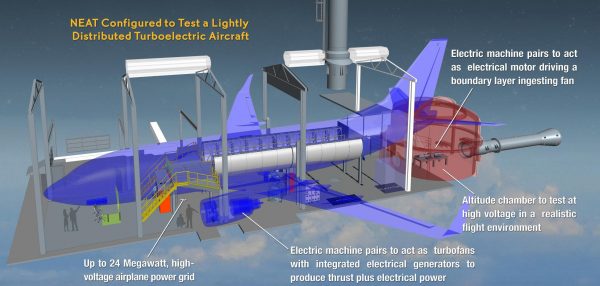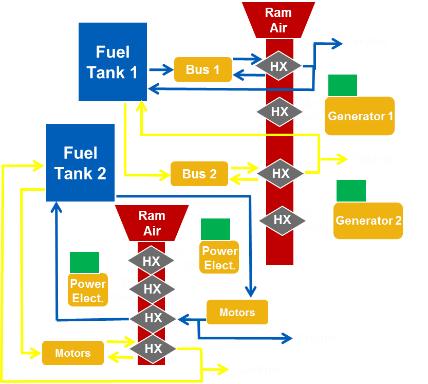Electrified Aircraft
NASA Electric Aircraft Testbed (NEAT)
NASA is investing in Electrified Aircraft Propulsion (EAP) research as part of the portfolio to improve the fuel efficiency, emissions, and noise levels in commercial transport aircraft. Turboelectric, partially turboelectric, and hybrid electric propulsion systems are the primary EAP configurations being evaluated for regional jet and larger aircraft.

The goal is to show that one or more viable EAP concepts exist for narrow-body aircraft and mature tall-pole technologies related to those concepts. As part of this effort, an electric aircraft power system test facility, NASA Electric Aircraft Testbed (NEAT), was built at the NASA Glenn Research Center’s Plumbrook station. The correct building blocks are in place to have a viable large-plane EAP configuration tested by 2025 leading to entry into service in 2035 if the community chooses to pursue that goal.
Thermal Recovery Energy Efficient System (TREES)
This mission responsive R&D project will transform thermal management of aircraft from a necessary burden into a sought after asset by forming a waste heat energy recycling loop using flight-weight ducted acoustic waves and heat pipes embedded within the airframe.
This technology is key to enabling future electric aircraft propulsion and advanced directed energy weapons in military warplanes because of the significant amount of low grade waste heat being generated within high power insulated composite body vehicles.
It is important to invest in this technology because it is the only known thermal management solution that reduces vehicle weight, improves vehicle performance, minimizes vehicle heat signature and recycles all the distributed low grade waste heat back to the engine. This is a unique opportunity for the Center to simultaneously provide value to the commercial airline industry and national defense while positioning GRC to lead a potential new NASA program area with significant system level vehicle impacts.
This project will transform how waste heat is managed on aircraft by successfully demonstrating a novel NASA patented (Patent No. US 10,507,934 B1, December 17, 2019) aircraft waste heat recovery and recycling system. The objective is to remove low-grade waste heat that is generated throughout high-power composite body aircraft while improving overall vehicle performance.
Prefer a thermal management technology that:
- Improves fuel efficiency.
- Reduces emissions.
- Removes heat from small core engines, more electric composite aircraft, and high power electric propulsion systems.
- Reduces vehicle mass.
- Reduces thermal signature for military.
Fuel Savings
Commercially attractive solution would achieve >15% fuel savings
 Current state of art solutions include:
Current state of art solutions include:
- Ram air HX:
- Adds weight and aircraft drag.
- Convective skin cooling HX:
- Adds weight, drag, and inefficient.
- Dumping heat into fuel:
- Limited thermal capacity.
- Dumping heat into lubricating oil:
- Limited thermal capacity.
- Active cooling:
- Adds weight and consumes fuel.
- Phase change cooling:
- Adds weight and limited capacity.
- Heat pipe, multiphase, vapor compression:
- Adds weight and consumes fuels.
The basic objective is to utilize a new class of thermo-acoustic technology to passively collect, transport, and recycle waste heat produced throughout the aircraft. This project will design, build, and test TREES at the NASA Electric Aircraft Testbed (NEAT).
